| ||||||||||||||||
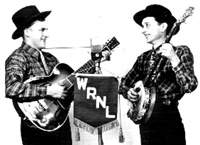
Hillbilly-Music.com—The People. The Music. The History.
|
 |
|||||||||||||||||
|
About the Group
About The Group Carl Patton McConnell was one half of a duo. The other half was a cousin, Doc Addington, who was a brother of Mother Maybelle Carter. Together, they became known as Doc and Carl. Doc was known for his guitar playing while Carl played mostly the banjo. Carl left behind an essay that told of his early career and the roads he and Doc travelled together. Carl Patton McConnellCarl was born January 24, 1913, on a farm in Big Moccasin Valley, at the foot of the north side of Clinch Mountain. he wrote was born in an old log cabin that had been the birthplace of his mother and her four sisters and one brother. He was a Baptist by faith and the third child of a family of seven; five girls and two boys. Music seems to have run in the family. He wrote, "My mother could do a pretty good job at playing the auto harp and organ. She also sang soprano and alto parts. Three of my sisters could play the organ and sing real well. ... My mother’s parents were Mr. And Mrs. B. M. Francisco. My Grandma Francisco was an excellent old-fashioned singer, with a beautiful, loud, clear voice. She had the reputation of being able to do more good with her singing in the old revival meetings than a lot of preachers could do with their preaching. They sent for her and came after her from miles around to get her to help sing and take part in the old-time country revival meetings. It was well known in those days that she spent a large portion of her time in this manner. Carl wrote that Grandpa Francisco was a farmer and owned one of the larger apple orchards in the area 'high up under the north side of Clinch Mountain. His grandpa Patton McConnell owned and operated a roller mill in MOccasin Valley, operating flour, corn and buckwheat mills. Next door was a saw mill and a planing mill, which used a turbine powered by water flowing by gravity from a concrete dam located just a couple hundred feet above the old mill place. In addition, there was a blacksmith shop, general store and a dwelling house. Carl described it as a "stomping ground and gathering place for all the surrounding neighborhoods." Carl writes of his first musical instruments and his learning and style. The first banjo that I ever owned was a little $9.95 Supertone five-stringer that I ordered from Sears, Roebuck and Company in January 1931. After a few days of plunking around, I learned to start a couple of tunes. The first one was “Goin’ Down in Town”. The second was “Down the Road”. Doc AddingtonBarnett McConnell, Jr. (stepson of Doc Addington) wrote an essay writing of Doc's early life. Hugh Jack Addington, Jr. was born on November 2, 1913 in the Addington Frame community of Scott County, Virginia, the eighth child of Hugh Jack and Margaret Kilgore Addington. While still a very young lad, Hugh J. Jr. became known as "Doc", a nickname given to him by his Uncle Milburn Nickels who lived near his home on Copper Creek. Uncle Mil Nickels also had nicknames for Doc's brothers that followed them throughout their life - Dewey was known as "Duke", David J. was known as "D. J." William B. was known as "Sawcat", Milbern B. was known as "Toobe", and Warren was known as "Bug". Carl wrote of how he and Doc first came to get together with their musical talents. Doc Addington and I are close kinfolk’s. His dad and mine were first cousins. My daddy’s mother was a distant cousin to Doc’s mother, both being descendants of the Kilgore generation. That makes us even a little more akin. But Carl and Doc would get together eventually. Carl writes of the first time he got to hear Doc's guitar playing.
"I had heard quite a lot about Doc’s fancy guitar picking for about a couple of years. Up until this time, I had never had the chance to hear him. The following fall, he and “Groundhog” dropped in one night at the home of our neighbors, Boyd and Will Quillin. A big bunch of us had gathered there for one of our usual musical parties. Doc and Carl, The Virginia Boys
As Maybelle became part of the Carter Family singing group in the late 1920's and early 1930's, Doc was singing and playing with a young banjo picker, Carl McConnell, who became his life long friend. Doc and Carl were third [third?] cousins and they first played music together at Uncle Mil's house on Copper Creek. Very soon after this singing debut, Doc and Carl began calling themselves "The Virginia Boys" and played together regularly at social gatherings throughout the area. Their reputation as musicians increased and soon they were playing and singing on WOPI in Bristol. Carl shed some light on how their working together began.
In the midst of all the corny mountain music making, Doc and Fiddlin’ Jimmy D. Cress spent the months of August and September 1934 at our home. They helped us work on the farm, and each night after supper, we would fiddle and frolic until late bedtime. Most of these nights, we had a bunch of neighbor visitors as an audience. This always stimulates a musician somewhat and makes him put a little more into his picking. As I have already stated, Jimmy D. Cress was a top old time fiddler on a few of the old tunes such as: “Cumberland Gap”, “Cackling Hen”, and others. He also had a couple of tunes on which he did some nice trick fiddling. These two tunes were: “The Drunken Hiccups” and “Pop Goes the Weasel”. Let's go back to a humorous episode Carl wrote of when Doc asked him to come to a 'music party' they were going to have and told Carl to bring his banjo. But getting to that part was quite the effort and perhaps typical of traveling musicians - they all have their road stories. " My brother Kenneth and I saddled our dappled gray, half-percheron, work horses, old Frank and Bird, and started on the four-mile rough trail across the two ridges and valleys. At the halfway mark, across the first ridge and down into the valley, in the west end of Taylor town community, we stopped by Beacher Smith’s home place. He met us at the yard gate. He was headed for the party also. As we were approaching Beacher’s home, we noticed a black looking storm cloud rising from the west and coming in our direction. Doc and Carl began playing for the folks in their area at other musical gatherings. The newspapers of that era often contained little tidbits of the comings and goings of people and enjoyable times. In June of 1936, Doc and Carl visited the home of Mr. and Mrs. Albert Quillin in Lone Star. Other guests were present as well. Doc and Carl entertained the folks with their music and, "the music was enjoyed by all." A couple of months later, they were playing for folks at the home of Mr. and Mrs. W. A. Moore. By this time, they were now known as 'radio musicians'. Again, the unnamed author noted, "the music was very much enjoyed by all." In Snowflake, VA, we read that 'quite a crowd gathered at the home of Mr. and Mrs. Albert Quillin on an August night in 1936. They were there to hear "Dock Addington and Carl McConnell make music." Even when they were just visiting relatives, it made the local news. On one occasion in August 1936, the 'musicians of Maces Spring, VA' were visiting relatives in the section of Nickelsville, VA. Doc and Carl were sent to WHAS in Louisville, KY for a time by the Consolidated Drug Company in February of 1939. According to Carl's essay, they were on the Early Morning Jamboree show from 6:30 am to 7:30 am. He wrote that the jamboree consisted of Uncle Henry's Kentucky Mountaineers, Sally and the Coonhunter, Sunshine Sue and Her Rock Creek Rangers, Gordon Sizemore and Little Betty, Joe and Al - The Chuckwagon Boys and Pat McAdary.
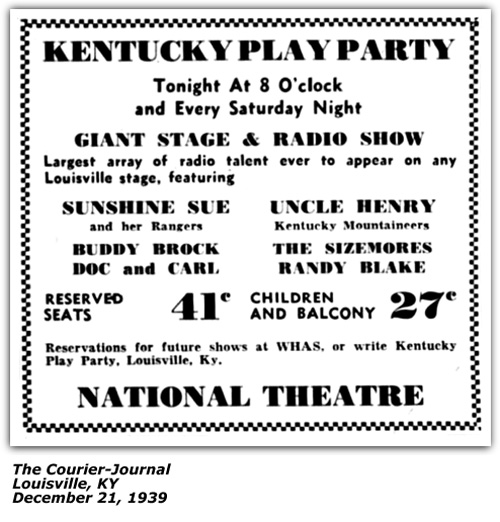
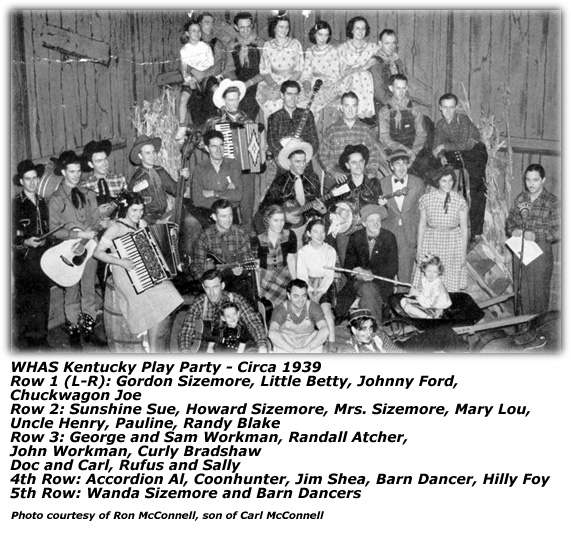
Carl mentions they were supposed to work at the station from September through May with June through August being a summer vacation break for them. The Kingsport Times in Tennessee documents occasions where Carl drove back to visit his family in Snowflake, VA. A search on Google maps shows that today it is nearly a 300 mile drive, taking almost 5 hours.
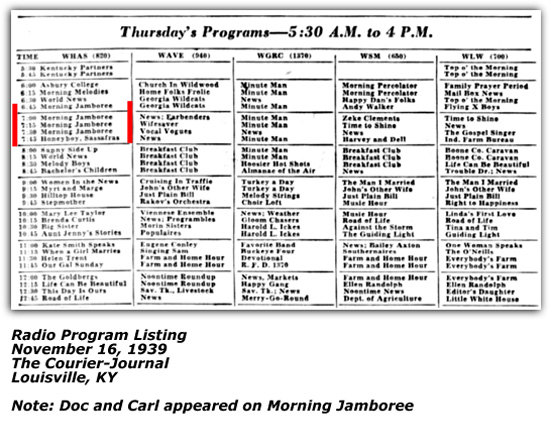
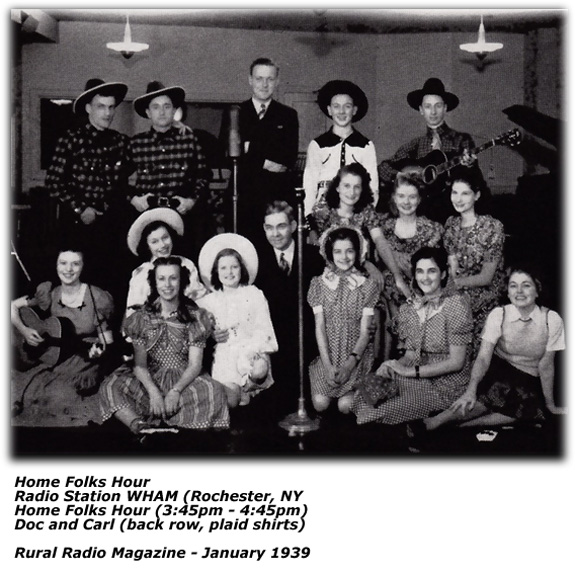
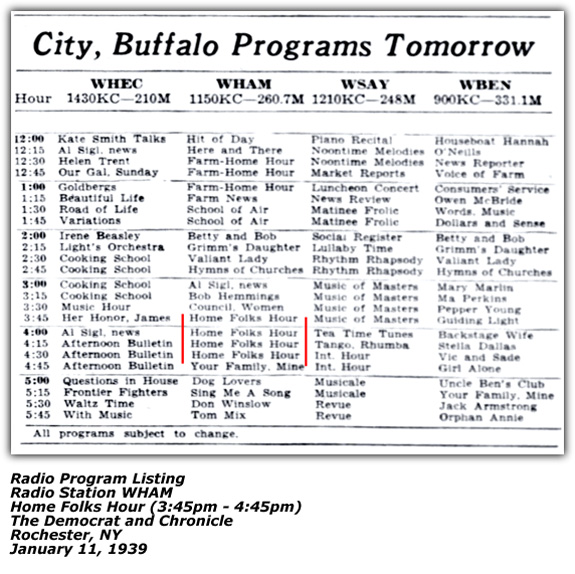
Doc and Carl were transferred Consolidated Drug Company to Station WKRC, Cincinnati, Ohio, They had two fifteen minute programs each day, until the last of May when the usual summer vacation season started. A group of nine entertainers left Chicago in January 1939 to start a new program called the "Home Folks Hour" over radio station WHAM in Rochester, NY. The show was to air from 3:45 pm to 4:45 pm Monday through Friday. It was suggested by Art Kelly in Rural Radio magazine that 'down-to-earth' type of show were far and between. The show was to feature old time songs, hoe-downs, hillbilly ditties and ballads of the plains and hills. The appears to have resonated with the Rochester listening audience. Mr. Kelly readers the ensemble included Doc and Carl, the Kasper Sisters, Chuckwagon Boys and Chuckwagon Joe, Barbara and Larry, Little Bett, Gen Kasper, Fiddlin' Larry Jeffers and Accordion Al. He wrote that Doc and Carl hailed from the hills of old Virginia. Together they sang hymns and songs of the hill folks. Little Betty Jeffers, all of six years old, was considered the sweetheart of the gang and known for her yodel specialties. Barbara and Larry Jeffers were born in Jackson, Florida and had a 'colorful record' in both radio and vaudeville. Barbara and Larry were twins and Little Betty was their sister. The Kasper Sisters had previously been with the National Barn Dance, Pappy Cheshire'Barnyard Jamboree, vaudeville and had already been on nine radio stations. The girls, Betty and Gen did harmony, with Betty playing the guitar. Then Joe Franks who was from Chicago had the role of "Chuckwagon Joe" and had been on the radio for four years up to that point. He was said to play guitar and thumped a mean doghouse bass. Finally, Elmer Witte who was known as Accordion Al, was born in San Francisco, CA, had traveled with the WLS road shows and appeared on the Barn Dance with Hal O'Hallaran.
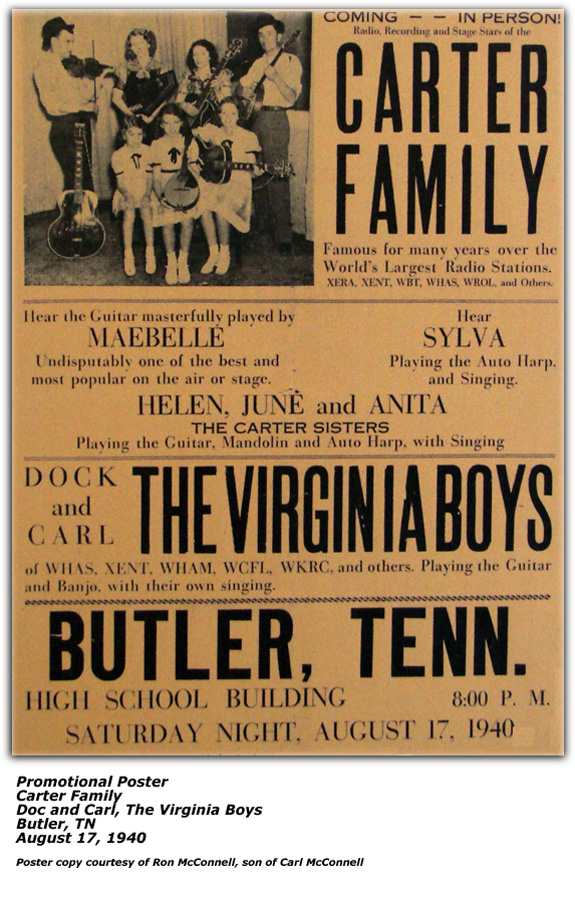
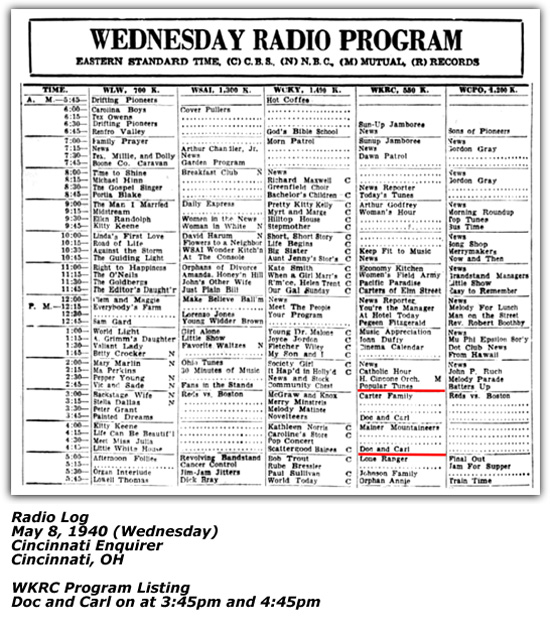

Doc recalls that the first part of June 1940, Doc and Carl hooked up with Mother Maybelle and the Carter Sisters - Helen, June, and Anita, along with A. P. Carter’s youngest sister, Sylvia, who was a good singer as well as a good guitar and auto harp picker. All summer long, they made personal appearances in the eastern half of Tennessee, southwest Virginia, and all down through North Carolina, clear to the coast, playing school houses, court houses, lodge halls, and an occasional theater. They continued making those shows, right on up into the month of September, when they had to quit in order that the Carter Sisters could attend school at Hiltons, Virginia.
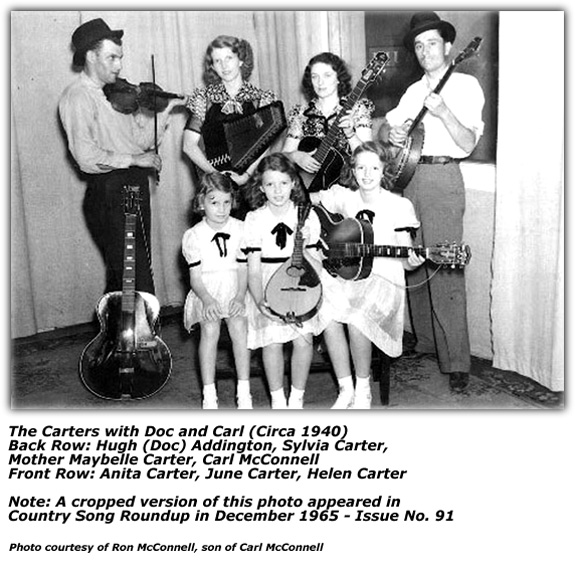

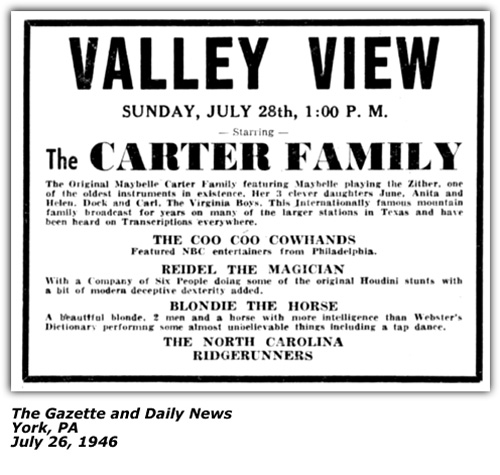
Carl's son, Ron, related humorous incident from his memories by email.
Sometime during 1944-1945 when Curley Bradshaw was a Blue Grass Boy, Doc Addington was in the military (Note: According to online records Doc registered in the U. S. Army on November 27, 1942 and was discharged on September 27, 1945), and Daddy was at his barbering, and Bill Monroe had a gig in Gate City, VA. Note: After reading that story, you wonder why the musicians would pass up a home cooked meal and instead pay for restaurant cooking. Doc and Carl met up with Mother Maybelle Carter and her daughters again in the summer of 1946. The Carters had returned to Richmond and were being heard over WRNL. A promotional picture taken helps date the picture as it is advertising a movie called "Renegades" that was to begin showing at the Byrd and State Theater on Wednesday, June 19, 1946. The movie starred Evelyn Keyes, Willard Parker, Larry Parks and Edgar Buchanan. While the newspaper ads for the film do not indicate folks would see entertainment, the signboard in the picture indicates they were going to perform at 5:45 pm. Later, on November 30, 1946, Mother Maybelle and the Carter Sisters (Helen, June and Anita) would debut as regular cast members of the WRVA Old Dominion Barn Dance.
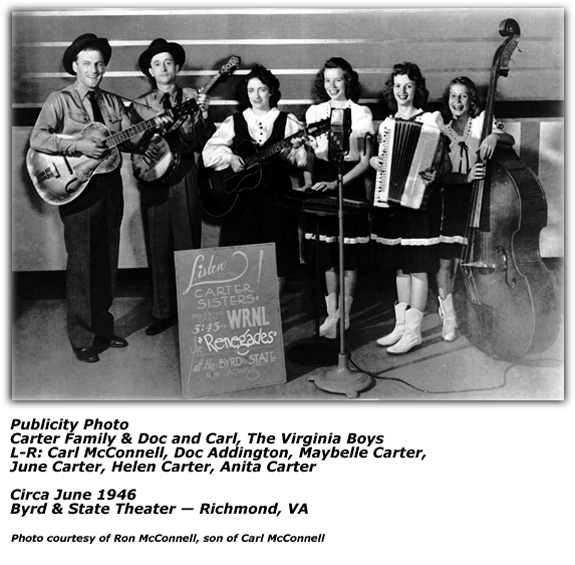
In September 1946, Doc and Carl returned to Scott County and after making a few local personal appearances with the Carters. Doc and Leota and four of their children - Shirley, Jack, Sue, Kay, (Dale was born in October) - returned to Indiana where Doc resumed his job at the Firestone Rubber Company. By then Carl and Mabel had also started a family with the birth of their son, Ronald, in 1941 and were hoping for another addition to their family. Theresa, their daughter, was born the next year in late 1947. Once more their music career was on hold and Carl returned to the barber business at the Scott Barber Shop in Gate City. During the next twenty-five years, they only played together occasionally when Doc and his family returned to Virginia for brief visits with his kin folks. Carl would play three or four times a year with Mabel's brothers, Howard, Edd and Glen Moore. Ron McConnell wrote of Doc and Carl, "In the present era, the Doc and Carl songs might be called old-time country as contrasted to the Nashville country sound. June Carter referred to Doc and Carl as the "jazzy side of the family." It was pre-bluegrass since Bill Monroe was still working out his bluegrass sound during that time and had it essentially done by late 1946. Charlie Monroe was playing at another Louisville radio station and contacted WHAS to have Doc and Carl stop performing Monroe Brothers songs. They never performed them again. Some years later Carl invited Bill Monroe and his Blue Grass Boys over for lunch and a jam session the day after their show in Gate City - much to Mabel's surprise." In the 1950's Carl had filled a notebook of full of song lyrics that he had written and hoped one day to play and maybe record with Doc. Like many mountain musicians, neither Doc nor Carl read or wrote music. The melodies for their songs were all stored in their heads. But the notebook of song lyrics disappeared from his banjo case at a gig in Nickelsville. He never wrote the songs down again. One wonders what lyrics and tunes were lost that night.
The Barber / Dog BreederRon wrote of his father's later years, "Although his music career was on a long-term hold, Carl was a man with many other interests and those who knew him well were aware of his passion for breeding mountain cur dogs. But few likely know that Carl was one of the organizers of the Mountain Cur Club in 1957 or that he was a co-founder of the Stephens' Breeders Association. The Mountain Cur Club was later renamed the Original Mountain Cur Breeders Association. Carl is credited with being instrumental in helping to save these old mountain hunting dogs from extinction. These faithful working dogs were/are used to hunt raccoons and bears. His love for these mountain dogs continued throughout his life. Scott County is home to folks descended from immigrants from Ireland, Scotland, England and Germany. There are also now many four legged residents descended from Florida immigrants. By the mid-1950's, after 150 years of hunting, raccoons in Scott County were rare. Carl and the coon hunting club purchased many crates of raccoons in Florida and shipped them by train to Gate City for release around the county. The great-great-grandparents of that raccoon in your backyard probably were some of Carl's Florida raccoons. Doc's Return To Indiana — One More Round Music MakingAfter Doc left Virginia and returned to Indiana, music continued to be a dominant force in his life. When he wasn't working at the Firestone Rubber Company, his days off were frequently spent "jamming" with local musicians who were constantly dropping by his house to do a little picking and singing. Doc and Leota divorced in the early 1970's. After Doc retired from Firestone in 1971, he returned to Scott County and he and Carl once again began to play together on a regular basis. In 1973, Doc married the widow of Barnett McConnell, Sr., Georgia Hartsock McConnell, and they lived in the Addington Frame community near his birthplace.In the early 1970's, Doc and Carl recorded an album at Johnny Cash's studio in Hendersonville, TN. However, the mix was wrong with Carl's banjo being prominent and Doc's guitar in the background. It was not the signature "Doc and Carl" sound and they were not happy with the result. Doc, Carl and Mabel recorded a gospel album, but the master tape was lost when the producer's studio was flooded and the record was never issued. During the next few years in the 1970's, Doc and Carl played and sang with Janette Carter at the Carter Fold; The Smokey Mountain Folk Festival in Cosby, Tennessee; The National Folk Festival at Wolf Trap Farm, Vienna, Virginia; The Cumberland Gap Jubilee, Lincoln Memorial University, Harrogate, Tennessee; Clinch Valley College, Wise, Virginia; Blue Grass Festival, Nora, Virginia; and numerous family reunions, homecomings, churches, and parties throughout Scott County. They also performed on Jimmy Smith's television program on Channel 19, WKPT, in Kingsport a nd Cas Walker's television program on Channel 10, Knoxville, Tennessee. Carl's wife, Mabel, an excellent vocalist, appeared with Doc and Carl on most of these programs. Doc and Carl's last paid performance together was likely the A. P. Carter Memorial Festival in Maces Springs, Virginia in August 4 - 6, 1977. Coincidentally, that marked the 50 th anniversary of the Carter Family recordings with the Victor company. The reader might wonder, 'whatever happened to those border radio transcriptions'? Ron shares the history behind it, pieced together over the years. "The most that Carl could learn from his research was that the Doc and Carl Border Radio show recordings had been worn out in the 20 years they were played. The discs were thrown out and used for roofing shingles by the local folks. But some recordings did survive. Amazingly, some WRNL Richmond recordings from 1946 with Mother Maybelle, the Carter Sisters, and Doc and Carl were recovered from a garbage dumpster during a rain storm about year 2000, long after the families believed that all of the old Doc and Carl music had been lost forever. "
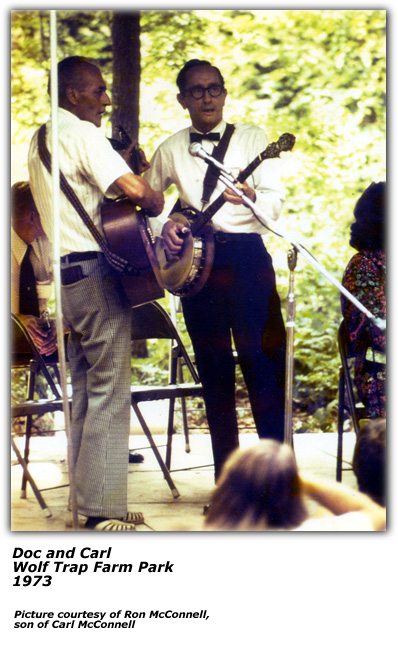 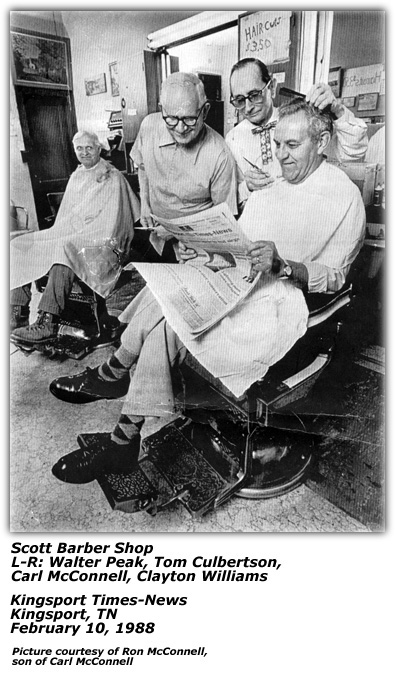
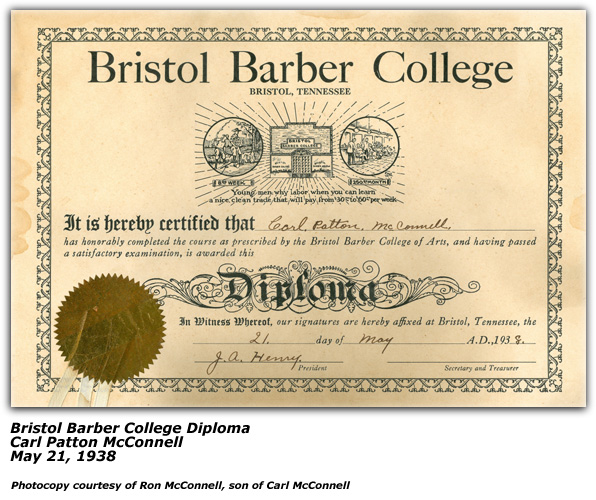
Ron sent along some other photos during our email exchanges. One included Doc and Carl performing at the Wolf Creek Trap Farm in 1973. He also sent along a photo of Carl at his 'Scott Barber Shop' from a 1988 Kingsport Times-News promotional ad for the paper. The paper describes the four gentlemen as: Carl McConnell and Tom Culbertson — Barbers and Times-News readers The newspaper ad went on to further quote Carl's support of the paper. "Of all the reading materials I've put out for customers here at "Scott Barber Shop," I'd say the Times-News gets more attention than anything else.
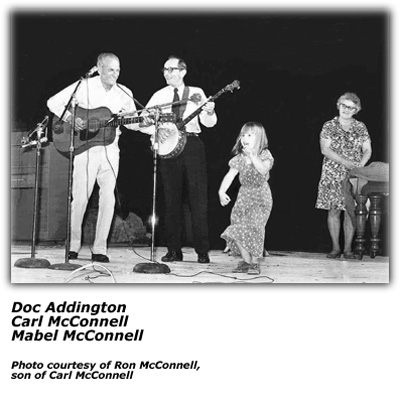 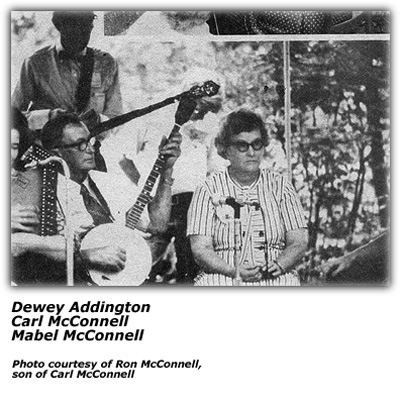 Ron also wrote of some of the options or choices that Doc and Carl made along the way that might lead to 'what if' or was it the 'right choice'. Doc and Carl felt they let two opportunities slip away that could have significantly altered their careers. In 1939 and again in 1940 they were invited to make some recordings for The Blue Bird Recording Company, later known as RCA. They declined the invitation. Also, in the spring of 1940 they were invited to accompany Dick Hartman, originator and leader of the famous "Tennessee Ramblers", to Hollywood to appear in two movies; one with Gene Autry and one with Tex Ritter. Again they declined the invitation. Carl had another brush with Hollywood in 1983 when a scene for the movie The River starring Mel Gibson and Sissy Spacek was filmed with Carl chasing away a drunk from in front of the barber shop. That scene ended up on the cutting room floor. Had Doc and Carl pursued these opportunities their lives and those of their families may have been completely different, for good or worse, who can say?
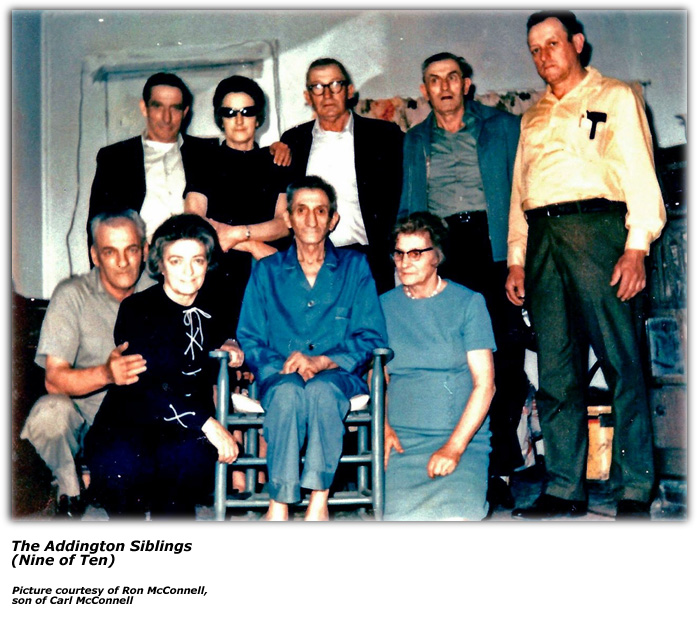
Last ChordsDoc's health began to fail in the late 1970's. When his wife, Georgia, died in 1981 he moved back to Indiana. Doc was living with his son Dale and his family in Bloomington, Indiana when he passed away on July 4, 1988. He was buried in the family cemetery near his boyhood home in the Addington Frame community, Nickelsville, Virginia. Carl finally retired from the barber business in 1993 after he became too ill to work. He passed away on May 27, 1994 and is buried in the Holston View Cemetery in Weber City, Virginia.Ron writes, Doc and Carl were humble men with kind and gentle personalities. They both loved life and they loved people and never spoke unkindly of anyone. In all their years of working and traveling together, they never had a serious disagreement. Many people throughout Virginia and numerous other States enjoyed the music of Doc and Carl over the years. Some of the "Doc and Carl" songs include
Since this is about a tale of two storied families, it is appropriate to document the other siblings in Doc and Carl's family to show the family circle / ties.
Credits and Sources
|